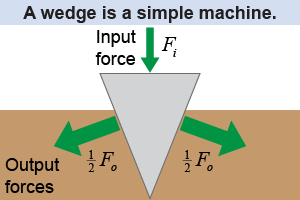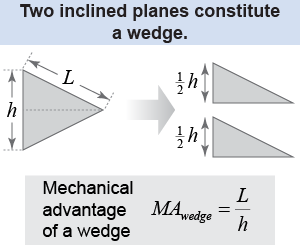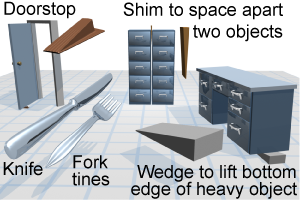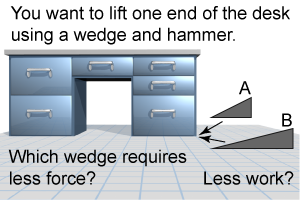|
 Do you like to cook? If so, then you regularly use a knife, which is also a wedge—a class of simple machines. A wedge has a tapered cross section: thick on one end and thin on the other. The thin end is often inserted into a crevice to split the object when an input force is applied to the thick end. The input force causes two output forces to be generated normal to the two angled faces of the wedge.
Do you like to cook? If so, then you regularly use a knife, which is also a wedge—a class of simple machines. A wedge has a tapered cross section: thick on one end and thin on the other. The thin end is often inserted into a crevice to split the object when an input force is applied to the thick end. The input force causes two output forces to be generated normal to the two angled faces of the wedge. 
|
 Divide a wedge along its plane of symmetry and what do you get? You get two inclined planes! The physics behind the forces acting on a wedge is similar to the physics of a ramp because both are types of inclined planes. Similar to two back-to-back ramps, the mechanical advantage of a wedge is the ratio of the length of the sloped side to the width of the thick end of the wedge, as calculated from equation (12.8).
Divide a wedge along its plane of symmetry and what do you get? You get two inclined planes! The physics behind the forces acting on a wedge is similar to the physics of a ramp because both are types of inclined planes. Similar to two back-to-back ramps, the mechanical advantage of a wedge is the ratio of the length of the sloped side to the width of the thick end of the wedge, as calculated from equation (12.8). 
|
| (12.8) | | | MAwedge | = | mechanical advantage | | L | = | length of wedge (m) | | h | = | maximum thickness
of wedge (m) |
| Mechanical advantage
of a wedge |
|
 Wedges have many uses and are not just for splitting wood. Wedges can be used to hold objects in place, such as in a doorstop. The tines at the end of a fork are each a wedge. The sharp edge of a knife is a thin wedge forcing apart the material being cut. A fairly small downward force on a sharp blade can easily cut food while it takes a much larger force if the knife edge is blunt.
Wedges have many uses and are not just for splitting wood. Wedges can be used to hold objects in place, such as in a doorstop. The tines at the end of a fork are each a wedge. The sharp edge of a knife is a thin wedge forcing apart the material being cut. A fairly small downward force on a sharp blade can easily cut food while it takes a much larger force if the knife edge is blunt. 
|
Tony is building a small pyramid in his backyard. The final 500 kg block will have to be moved into a position 5 m above the ground. Tony can push the block on rollers up a ramp with a force of 1000 N. How long must his ramp be? | Asked: | length L of the ramp | | Given: | input force Tony can apply, Fi = 1000 N; height of the ramp, h = 5 m;
mass of the block, m = 500 kg; acceleration of gravity, g = 9.8 N/kg | | Relationships: | mechanical advantage: MA = Fo/Fi; for a ramp: MAramp = L/h | | Solution: | Tony needs to move the block vertically by 5 m, so the output force he is working against is gravity or Fo = mg.
We have two expressions for mechanical advantage (above), so equate them and solve for the length L of the ramp: | | Answer: | The ramp needs to be 24.5 m long. | 
|
 You want to lift one end of the desk by using a hammer to pound a wedge under the desk. You have two wedges available to use, both of which have the same height at one end.
You want to lift one end of the desk by using a hammer to pound a wedge under the desk. You have two wedges available to use, both of which have the same height at one end. - Which wedge requires less force from the hammer to insert it fully under the edge of the desk?
- Which wedge requires less work?
 |
- The mechanical advantage of wedge B is larger because it has a shallower slope, so less input force is required from the hammer to drive it into place.
- The same work (or energy) is required to insert either one to lift the desk the same height.

|

